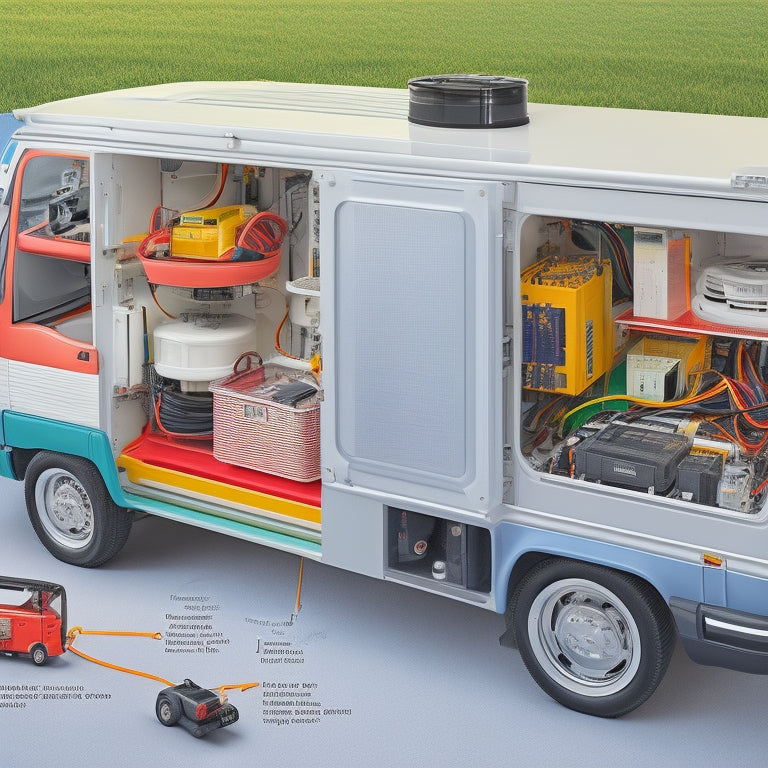
Mastering DIY Van Electrical Systems: Essential Tips
Share
We're converting our vans into homes on wheels, and a reliable electrical system is vital. To master DIY van electrical systems, we need to start with the basics: understanding charge sources, battery banks, and electrical safety. We prioritize system safety and component selection to guarantee efficient energy distribution. Next, we optimize battery performance by monitoring temperature effects, maintaining a schedule, and optimizing charging profiles. Proper maintenance enhances longevity and performance. By understanding these essential tips, we're well on our way to designing a reliable system that powers our adventures - and there's even more to discover as we continue to refine our electrical system design.
Key Takeaways
• Prioritize electrical safety to prevent shocks, fires, and hazards by understanding the fundamentals of van electrical systems.
• Choose components that meet specific needs to ensure efficient energy management and minimize hazards.
• Optimize battery performance through proper maintenance, temperature monitoring, and adjusting charging profiles for optimal camping experience and safety.
• Ensure system safety through proper installation, component selection, and efficient energy distribution to reduce the risk of electrical shocks.
• Regular maintenance schedules, including water level checks and terminal cleaning, enhance battery longevity and overall system performance.
Understanding Van Electrical Basics
As we start designing our DIY van electrical system, it's important that we grasp the fundamentals of how energy flows and is managed within our campervan.
Understanding basic terminology is essential, so let's break it down: charge sources (solar, alternator, shore power) feed our battery bank, which powers our loads (lights, water pump, etc.).
We must prioritize electrical safety, ensuring our system is designed and installed to prevent electrical shocks, fires, and other hazards.
A solid understanding of these basics will help us create a reliable and efficient electrical system, keeping us and our campervan safe on the road.
Designing a Reliable System
By carefully selecting and integrating the right components, we can design a reliable DIY van electrical system that efficiently manages energy and minimizes the risk of electrical hazards. We prioritize system safety by choosing components that meet our specific needs and guarantee proper installation.
Component selection is essential, as it directly affects system performance and safety. We consider factors like battery type, charge sources, and load requirements to select the best components for our system. A well-designed system ensures efficient energy distribution, reduces the risk of electrical shocks, and provides a safe and reliable power supply for our van's electrical systems.
Optimizing Battery Performance
We prioritize optimizing battery performance to guarantee our DIY van electrical system operates efficiently and reliably, as it directly impacts our camping experience and safety.
Proper battery maintenance is essential for enhancing longevity and overall system performance. Here are some key considerations for optimizing battery performance:
-
Monitor temperature effects: Extreme temperatures can greatly impact battery performance and longevity.
-
Implement a regular maintenance schedule: Regularly check water levels, clean terminals, and make sure proper charging.
-
Optimize charging profiles: Adjust charging settings based on battery type and usage patterns.
- Avoid deep discharging: Prevent deep discharging to prolong battery life and maintain performance.
Frequently Asked Questions
How Do I Troubleshoot Electrical Issues in My Campervan?
As we navigate the dark alleys of electrical issues in our campervan, we employ fault finding and circuit analysis, scrutinizing every wire and connection, to illuminate the root cause of the problem and restore power to our home on wheels.
Can I Mix Different Battery Types in My Van's Electrical System?
We advise against mixing different battery types in our van's electrical system, as it can lead to battery compatibility issues and type mismatch complications, causing reduced performance, decreased lifespan, and potential safety risks.
What Safety Precautions Should I Take When Working With Electrical Systems?
We take safety precautions seriously, recognizing electrical hazards like shocks, fires, and electrocution. We wear safety gear, including insulated gloves and goggles, to minimize risks when working with electrical systems.
How Often Should I Inspect and Maintain My Electrical System Components?
We recommend conducting regular electrical audits every 3-6 months, using system checklists to inspect and maintain our electrical system components, ensuring peak performance, safety, and extending component lifespan.
Can I Upgrade My Existing Electrical System to Support Higher Power Loads?
We can enhance our existing electrical system to support higher power loads by evaluating our power upgrades, identifying capacity bottlenecks, and strategically replacing components to increase electrical capacity, ensuring a reliable and efficient system.
Related Posts
-

What Tax Deductions Apply to Sustainable Building Materials?
You can claim various tax deductions for sustainable building materials, thanks to over 40 federal tax incentives sup...
-

Why Choose Solar Composting Toilets for Your Home?
By choosing a solar composting toilet for your home, you'll greatly reduce your environmental impact, slashing your w...
-

Why Grow Up? Vertical Gardens Transform Urban Living
As you change your urban living space, you're not just growing up - you're bringing nature back into the heart of the...


